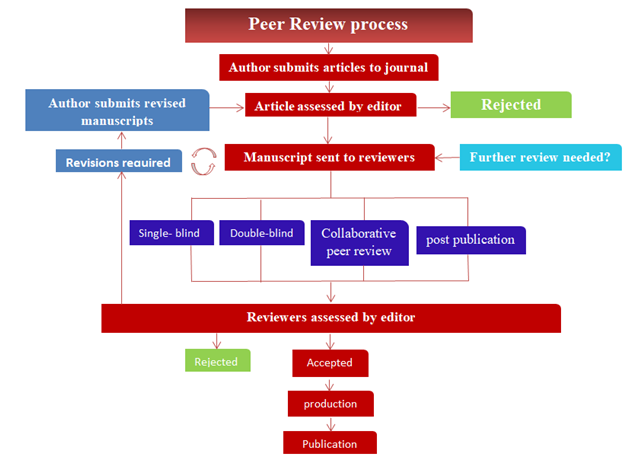Peer review
Peer review is the system used to evaluate the quality of a manuscript before it is published. This journal operates a double –blind peer review policy involving 3 external reviewers. Independent Researchers in the pertinent research area assess submitted manuscripts for originality, validity and significance to assist editors with deciding if a manuscripts ought to be published in their journal.
The peer review can be comprehensively summarized into 10 steps. Explore what's involved below .
1.Submission of Paper
The relating or submitting author submits the paper to the journal. This is typically through an online system for example Scholar- One Manuscripts. At times, journals may accept submission by email.
- Editorial office Assessment
The journal checks the paper's organization and plan against the journal's Author Guidelines to ensure it incorporates the required sections and stylizations. The quality of the paper isn't surveyed now.
- Examination by the Editor-in-chief (EIC)
The EIC checks that the paper is proper for the journal and is adequately unique and interesting. If not, the paper might be rejected without being checked on any further.
- EIC Assigns an Associate Editor (AE)
Our journals have Associate Editors who handle the peer review. In the event that they do, they would be appointed at this stage.
5.Invitation to Reviewers
Editor sends invitations to individuals the person accepts would be appropriate reviewers. As responses are received , further invitations are issued, if vital, until the necessary number of acceptances.
- Response to Invitations
Potential reviewers consider the invitation against their own aptitude , irreconcilable circumstances and accessibility. They then accept or decline. If possible, when declining, they may likewise elective reviewers.
- Review is Conducted
The reviewer puts time aside to read the paper a few times. The main read is utilized to form an initial impression of the work. In event that serious issues are found at this stage, the reviewer may feel comfortable rejecting the paper moving forward without any more work. Else they will read the paper a few additional occasions, taking notes in order to assemble a detailed point- by- point review. The review is then submitted to the journal, with a recommendation to accept or reject for update (normally hailed as either major or minor) before it is reexamined.
- Journal Evaluates the Reviews
The dealing with editor thinks about all the returned reviews before setting on a general choice. If the reviews differ widely, the editorial manager may welcome an extra reviewer in order to hear an additional point of few before setting a decision.
- The Decision is Communicated
The editor sends a decision email to the author including any relevant reviewer comments. Regardless of whether the remarks are mysterious or not will rely upon the type of peer review that the journal works.
- Next step
If accepted, the paper is sent to production. In the event that the articles is rejected or sent back for either major or minor revision, the dealing with editor should incorporate useful comments from the reviewers to enable the author improve the articles. Now, reviewers ought to likewise be sent an email or letter letting them the result of their review. If the paper was sent back for revision, the reviewers ought to hope to get another rendition, except if they have quit further support. However, where only minor changes were requested this follow up review might be done by the handling editor.
Types of peer review
There is one type of peer review utilized by University of Thi-Qar Journal of Science includes double blind. Double blind is reviewer doesn't know the identity of the author, and vice-versa.
.
Why do peer review ?
Peer review is a necessary part of scientific publishing that conforms the validity of the manuscript. Peer reviewers are specialists who volunteer their time to help improve the manuscripts they review. By going through peer review, manuscripts ought to turn into:
More Robust- peer reviewers may point out gaps in a paper that require more explanation or additional experiments.
Easier to Read- if parts of your paper are hard to comprehend , reviewers can suggest changes.
More Useful- peer reviewers likewise consider the significant of your paper to others in your field.
Time allowed for the reviewers: The reviewers are expected to complete their reviews within three weeks. Reviewers may request an extension of one week beyond the review due date.













